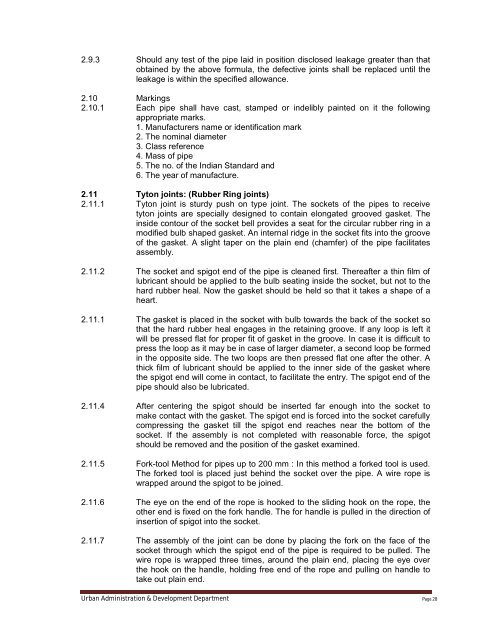Specifications Part 1 - Water Supply, Sewerage and Tube Well Works
Specifications Part 1 - Water Supply, Sewerage and Tube Well Works
Specifications Part 1 - Water Supply, Sewerage and Tube Well Works
Create successful ePaper yourself
Turn your PDF publications into a flip-book with our unique Google optimized e-Paper software.
2.9.3 Should any test of the pipe laid in position disclosed leakage greater than thatobtained by the above formula, the defective joints shall be replaced until theleakage is within the specified allowance.2.10 Markings2.10.1 Each pipe shall have cast, stamped or indelibly painted on it the followingappropriate marks.1. Manufacturers name or identification mark2. The nominal diameter3. Class reference4. Mass of pipe5. The no. of the Indian St<strong>and</strong>ard <strong>and</strong>6. The year of manufacture.2.11 Tyton joints: (Rubber Ring joints)2.11.1 Tyton joint is sturdy push on type joint. The sockets of the pipes to receivetyton joints are specially designed to contain elongated grooved gasket. Theinside contour of the socket bell provides a seat for the circular rubber ring in amodified bulb shaped gasket. An internal ridge in the socket fits into the grooveof the gasket. A slight taper on the plain end (chamfer) of the pipe facilitatesassembly.2.11.2 The socket <strong>and</strong> spigot end of the pipe is cleaned first. Thereafter a thin film oflubricant should be applied to the bulb seating inside the socket, but not to thehard rubber heal. Now the gasket should be held so that it takes a shape of aheart.2.11.1 The gasket is placed in the socket with bulb towards the back of the socket sothat the hard rubber heal engages in the retaining groove. If any loop is left itwill be pressed flat for proper fit of gasket in the groove. In case it is difficult topress the loop as it may be in case of larger diameter, a second loop be formedin the opposite side. The two loops are then pressed flat one after the other. Athick film of lubricant should be applied to the inner side of the gasket wherethe spigot end will come in contact, to facilitate the entry. The spigot end of thepipe should also be lubricated.2.11.4 After centering the spigot should be inserted far enough into the socket tomake contact with the gasket. The spigot end is forced into the socket carefullycompressing the gasket till the spigot end reaches near the bottom of thesocket. If the assembly is not completed with reasonable force, the spigotshould be removed <strong>and</strong> the position of the gasket examined.2.11.5 Fork-tool Method for pipes up to 200 mm : In this method a forked tool is used.The forked tool is placed just behind the socket over the pipe. A wire rope iswrapped around the spigot to be joined.2.11.6 The eye on the end of the rope is hooked to the sliding hook on the rope, theother end is fixed on the fork h<strong>and</strong>le. The for h<strong>and</strong>le is pulled in the direction ofinsertion of spigot into the socket.2.11.7 The assembly of the joint can be done by placing the fork on the face of thesocket through which the spigot end of the pipe is required to be pulled. Thewire rope is wrapped three times, around the plain end, placing the eye overthe hook on the h<strong>and</strong>le, holding free end of the rope <strong>and</strong> pulling on h<strong>and</strong>le totake out plain end.Urban Administration & Development Department Page 28
















